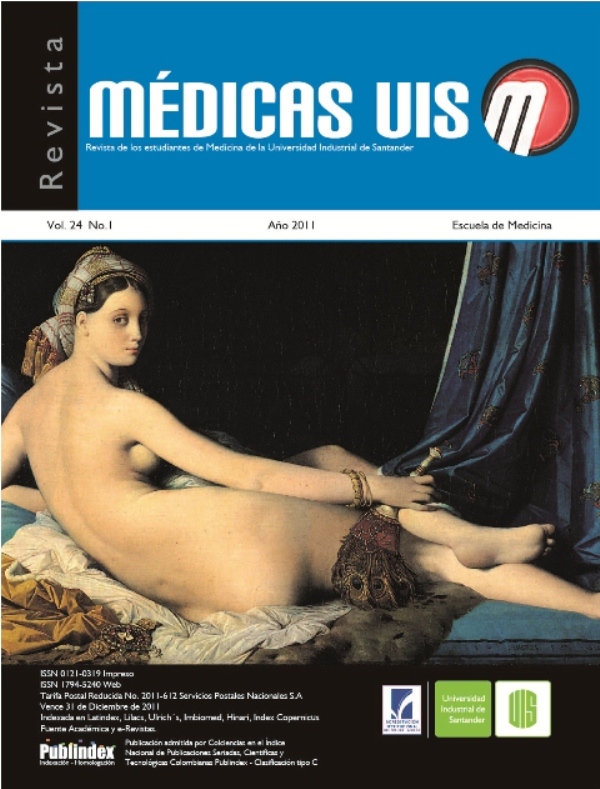Resumen
La presente revisión incluye la descripción de los diferentes tipos de nefrotoxicidad inducida por medicamentos de acuerdoa su clasificación histopatológica, mecanismo de generación, presentación clínica y medicamentos más frecuentementeimplicados. Para esta revisión fue realizada una búsqueda sistemática en el Index Medicus de artículos relacionados publicadosa partir de 1999, los cuales fueron seleccionados de acuerdo a su pertinencia. La nefrotoxicidad inducida por medicamentoses un hallazgo de gran importancia clínica, debido a su alta frecuencia y potencial severidad, así como al desconocimientode medidas preventivas en muchos casos. Las principales alteraciones renales producidas por medicamentos se puedenclasificar histopatológicamente, según la función renal alterada. De este modo, se encuentra la necrosis tubular aguda, lanefritis intersticial, la lesión glomerular y las alteraciones vasculares, que a su vez incluyen la microangiopatía trombótica,la aterosclerosis y la vasculitis. Finalmente, se hace una revisión de algunos medicamentos de uso habitual con alto potencialde nefrotoxicidad, haciendo énfasis en las recomendaciones de uso clínico dirigidas a optimizar la seguridad renal de estosproductos.
Palabras clave: Toxicidad de medicamentos. Riñón. Lesión renal aguda. Insuficiencia renal crónica. Enfermedadmedicamentosa. Efecto secundario.
Referencias
2. Kleinknecht D, et al. Drug-associated acute renal failure: a prospective collaborative study of 81 biopsied patients. Adv Exp Med Biol. 1987; 212:125-8.
3. Kaloyandes GJ, et al. Antibiotic and immunosupressionrelated renal failure. Philadelphia: Lippincott, Williams & Wilkins; 2001 Meyrier A. Nephrotoxicity of iodine contrast media. Ann Radiol.1994;37:286-95.
4. Mc William LJ. Drug induced renal disease. Current Diagnostic Pathology. 2007;(13):25-31.
5. John R, Herzenberg AM. Renal toxicity of therapeutic drugs. J Clin Pathol. 2009;62(6):505-15.
6. Markowitz GS, Perazella MA. Drug-induced renal failure: a focus on tubulointerstitial disease. Clin Chim Acta. 2005;351(1-2):31-47.
7. Valsecia M, Malgor L. Utilización de fármacos en insuficiencia renal. Disponible desde Internet en: http://www.med.unne.edu.ar/catedras/farmacologia/temas_farma/volumen5/11_rinion.pdf. Último acceso: 16 de noviembre de 2010.
8. Li C, Lim SW, Sun BK, Yang CW. Chronic cyclosporine nephrotoxicity: new insights and preventive strategies. Yonsei Med J. 2004;45(6):1004-16.
9. Bakker R C, Scholten E M, De Fijter JW, Leendert C P. Chronic Cyclosporine Nephrotoxicity in Renal Transplantation. Transplant Rev. 2004;18(1):54-64.
10. Sawaya BP, Briggs JP, Schnermann J. Amphotericin B nephrotoxicity: the adverse consequences of altered membrane properties. J Am Soc Nephrol. 1995;6(2):154-64.
11. Bakker R C, Scholten E M, De Fijter JW, Leendert C P. Chronic Cyclosporine Nephrotoxicity in Renal Transplantation. Transplant Rev. 2004;18(1):54-64.
12. Michael G. Lithium and the Kidney. Drug Safety. 1999;20 (3):231-43.
13. Johnson G. Lithium-early development, toxicity, and renal function. Neuropsychopharmacology. 1998;19:200-05.
14. Schrader R. Contrast Material-Induced Renal Failure: An Overview. Journal of Interventional Cardiology. 2005;18(6).
15. Gault MH.evidence for the nephrotoxicity of analgesics. Can Med Assoc J. 1972;107(8):756-8.
16. Tabibian JH, Tabibian N, Kaufman DM. Late-onset celecoxib-induced combined hepato-nephrotoxicity. Br J Clin Pharmacol. 2008;66(1):150-1. Epub 2008 Mar 5.
17. ltrumper, lA. monasterolo and MM Elías. Probenecid protects against in vivo acetaminophen-induced nephrotoxicity in male wistar rats. J Pharmacol Exp Ther. 1998;284:606-10.
18. Kunio D, katsuhiko I. Diabetes and hypertriglyceridemia modify the mode of acetaminophen-induced hepatotoxicity and nephrotoxicity in rats and mice. JJ. Toxicol. Sci. 2009; 34(1):1-11.
19. Jiang M, Dong Z. Regulation and pathological role of p53 in cisplatin nephrotoxicity. J Pharmacol Exp Ther. 2008;327(2):300-7. Epub 2008 Aug 5.
20. Hanigan MH, Devarajan P.Cisplatin nephrotoxicity: molecular mechanisms. Cancer Ther. 2003;1:47-61.
21. Rougier F, Claude D, Maurin M, Sedoglavic A, Duche M, Corvaisier S, Jelliffe R, Maire P. Aminoglycoside Nephrotoxicity: modeling, simulation, and control. Antimicrobial Agents and Chemotherapy. 2003;47(3):1010-16.
22. Marie P, Mingeot L. y Tulkens P. Aminoglycosides: Nephrotoxicity. Antimicrobial Agents and Chemotherapy. 1999;43(5):1003-12.
23. Morales L., Arévalo M. y Pérez F. Mecanismos implicados en la nefrotoxicidad producida por aminoglucósidos. Instituto Reina Sofía de Investigación Nefrológica. Departamento de Fisiología y Farmacología. Universidad de Salamanca. NEFROLOGÍA. 2000;20(5).FármacoNecrosis tubular agudaNefritis intersticialEnfermedad glomerularVascularFuncionalAnfotericina BCiclosporinaLitioAINEsCisplatinoAminoglucósidosVancomicinaBetalactámicosAntirretroviralesTabla 2. Mecanismos de nefrotoxicidad por medicamentos de uso habitualSe presentan los mecanismos de nefrotoxicidad de acuerdo a la clasificación histopatológica. La correspondiente alteración para cada fármaco se indica con el sombreado.
